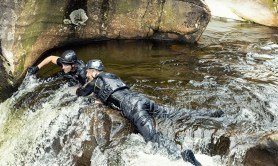

The key to having a fun camping trip in cold weather is staying at least relatively warm. That’s easier said than done, though, especially if you’re tent camping in the winter.
When the temperatures plunge and you’re sleeping in a shelter made of nylon, canvas, or polyester, you should have some tricks up your sleeve that’ll help keep you from becoming a human icicle—especially when you’re trying to get a good night’s sleep.
In very cold temperatures, you’ll lose body heat faster than you can generate it. Using a variety of strategies to keep your body temperature up and preserve heat you can generate inside your tent, though, you can stay warm, even on cold nights.
In this article, we’ll show you how to stay warm in a tent so you can stay as comfortable as possible while cold-weather camping.
The Basics: Staying Warm

At a Glance:
- Layer warm clothing
- Be smart about where you set up camp
- Eat warm food and drink warm drinks
- Stay active
- Stay dry
Wearing multiple clothing layers is critical to keeping warm inside your tent . . . or any time, really. At the minimum, when winter camping or whenever it’s cold, you should be wearing three layers: a base layer, an insulating layer, and an outer layer.
Base layers should be made out of moisture-wicking material. Insulating layers provide insulation that keeps your body heat in (fleece is a good option). Outer layers are waterproof to keep you dry and windproof to shield you from wind.
Where you initially set up camp matters, too. Set up in a sheltered area that won’t be exposed to too much wind, snow, or rain. Consider where the morning sun will shine, and place your tent there so you can maximize the sun’s warmth throughout the day.
For tips on setting up a tent on top of snow, check out our winter camping guide. Remember to never set up your shelter near dead or dying trees or steep snowy slopes (30-degree slopes and steeper qualify as avalanche risks), which could be potentially dangerous.
If there are no natural windbreaks nearby, such as a cluster of bushes, a fallen tree, or a mound of rocks, consider building a windbreak to shield your tent from excessive wind, which speeds up heat loss.
You can do this by piling up snow and shaping it into a wall, or by using a heavy-duty tarp (with tough grommets) and a sturdy rope.
Use the rope to tie the tarp up between two trees that are upwind of your tent. The tarp will act as a powerful windbreak, potentially better than most natural windbreaks.
Plan ahead so you have easy-to-prepare meals and beverages for your excursion.
Eating a hot meal and drinking a warm drink can make all the difference not only in regulating your body temperature but also in keeping you mentally feeling good as the mercury dips. Pack insulated containers and thermoses that will keep your food and drinks warm.
In general, to stay warm on a chilly camping trip, plan on staying active throughout the day. If your heart is pumping, your body is making heat, and your clothing layers will help keep that heat in. Any extra heat you have going into your tent will help you stay warm once you’re inside it.
One caveat to staying active, though, is that you also need to stay dry. If you’re sweating, you must remove sweaty clothes and switch to fresh base layers before bed.
Gear That’ll Help You Stay Warm

You’ll need the proper gear to stay warm in a tent on winter camping trips (or when camping in cold temperatures). Here is some guidance.
Choose the Best Camping Tent
Ideally, if you plan to spend time winter camping, you’ll invest in a four-season tent or a hot tent. Four-season tents are designed to hold heat in, while also allowing for some ventilation. Hot tents accommodate wood-burning stoves, which are one of several ways to heat your tent.
If you have a three-season tent, you can still camp in cold weather. However, consider insulating your three-season tent against the cold while winter camping (more on that later).
When choosing a tent for your next camping excursion in the cold, remember that bigger is not always better. A smaller space will stay warmer than a bigger space.
Build a Smart Sleep System
A heavy-duty, well-insulated sleeping bag with a temperature rating designed for freezing temps is a must for staying warm in your tent on a cold night. The best sleeping bags for winter often have a fitted style, with a shape that’s cut to resemble a human body.
This profile reduces energy loss since you won’t be wasting body heat to warm up an unnecessarily large rectangular sleeping bag.
Put layers between your sleeping bag and the cold ground, preferably more than one. For instance, bring along an insulated sleeping pad (or two sleeping pads) and a sleeping bag liner. Layer up even more with a camping blanket or quilt for maximum warmth.
The combined insulating power of a good sleeping pad, a warm sleeping bag, and a sleeping bag liner will help you achieve a good night’s rest on your next camping trip.
What’s your favorite sleeping system? Read more about the debate between quilt vs sleeping bag.
Tent Heaters
If you’re keen on winter camping, one of the best pieces of gear to keep you warm in a tent is a tent heater. There are electric and propane options that’ll really do the trick by transforming cold air into warm air in no time.
Note that a fuel-based tent warmer like a propane heater requires ventilation. While electric heaters don’t pose the same carbon-monoxide risk that fuel-based stoves and heaters do, tent heaters of any type are not recommended for use while you’re asleep.
You can also read up on various ways to heat your tent that do not involve using a tent heater.
Other Items to Add or Preserve Warmth
You might also consider adding these items to your camping gear to stay warm in a tent:
- Hand warmers and foot warmers
- USB-powered electric blankets and/or extra camping blankets
- Heated gloves or fleece gloves
- Extra layers to replace sweaty layers before sleep
- Wool socks
How to Insulate a Tent For Winter Camping

To maximize warmth inside your tent, you should insulate it (unless you already have a tent rated for four seasons). Start by laying a tarp down before you set it up, which will help insulate the tent floor against the cold ground.
Keep the tarp from extending past the edges of the tent if it is raining or snowing (so rain and melted snow don’t gather on the edges and pool beneath your tent).
To improve insulation in the walls of your tent, use a couple of tarps or space blankets. Attach one to the inside of the canopy using duct tape to act as an inner layer that traps heat.
You can use additional tarps or space blankets to seal off any drafty areas but don’t forget that ventilation is also important for staying warm and dry.
Bonus Tips for Staying Warm

- Wear a beanie or balaclava to bed to avoid losing heat from the top of your head.
- Put hand warmers inside your sleeping bag to warm it up before you get in.
- Place hot water bottles in your sleeping bag to increase the temperature inside before your body heat takes over and keeps it warm. Remove the bottles once they lose their heat.
- Sleep in the base layers you plan to wear the next day, and place the rest of your clothes for the next day in your sleeping bag to warm them up for the next morning.
How Cold Is Too Cold for Tent Camping?

There is no rule for how cold is too cold for tent camping. Some people who are very sensitive to cold may have a better time sticking to shoulder seasons and warm weather when camping. Others will do just fine using the strategies and tips discussed here for staying warm in a tent.
Before camping in cold weather, learn the signs of cold-related illnesses like hypothermia and frostbite. If at any point you feel yourself becoming dangerously cold and unable to warm up, seek medical attention as quickly as possible.










People have died using hand warmers in a sleeping bag because the take the oxygen these should never be used in a sleeping bag.